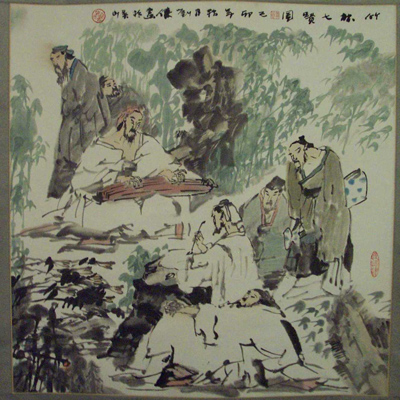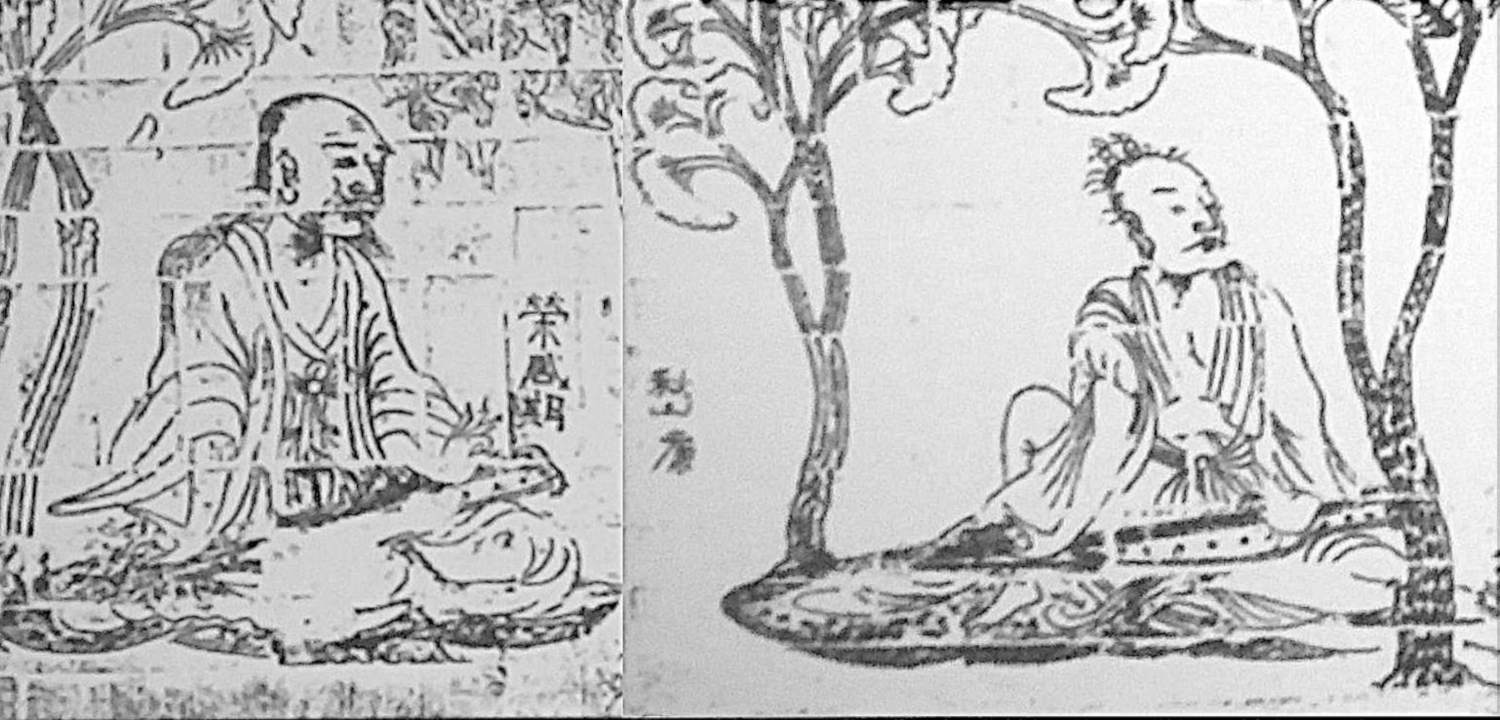|
T of C
Home |
My Work |
Hand- books |
Qin as Object |
Qin in Art |
Poetry / Song |
Hear, Watch |
Play Qin |
Analysis | History |
Ideo- logy |
Miscel- lanea |
More Info |
Personal | email me search me |
| Art Illustrating Guqin Melodies / Closeup of Xi Kang playing Guangling San | 首頁 |
| Xi Kang Illustrations | 嵇康圖 |

Xi Kang plays Guangling San at the execution ground
By Bai Yunli 1
Below:
Seven Sages
of the Bamboo Grove (Expand)
Xi Kang plays qin;
Ruan Xian has ruan;
Ruan Ji lies drunk
By Liu Jian 2
At bottom:
Xi Kang (right) and Rong Qiqi qin: left handed!
From clay brick rubbing of the Seven Sages at a tomb in Nanjing3:
left-handed qin or reversed image?4

|

|
Footnotes (Shorthand references are explained on a
separate page)
1.
Xi Kang plays Guangling San at the execution ground; by Bai Yunli (2002)
The inscription says, 譙君嵇康將刑,顧視日影,索琴彈之,畢曰﹕『廣陵散於今絕矣』。𡈼午雲立為世璋先生製。
The first part is extracted from the
SQMP Preface; after this it says, "In 2002 (Bai) Yunli made this for Mr. (Tang) Shizhang"
Return)
2.
Seven Sages of the Bamboo Grove, by Liu Jian (1999)
The painting shows 榮啟期 Rong Qiqi playing the qin and
Ruan Xian carrying his ruan; Ruan Ji is probably the one in front.
The inscription says, 竹林七賢圖(seal)己卯年巧月劉健畫於吳山(seal)
In the seal 健 Jian looks like 侓 Lu. Liu Jian, a well-known painter, was at the time 中國美術學院教授、副院長 a professor and vice principal at the China Academy of Art in Hangzhou.
(Return)
| 3. Xi Kang and Rong Qiqi play qin (ancient rubbing) | Above image of Xi Kang reversed |
 This rubbing, part of the complete set shown with the
Seven Sages of the Bamboo Grove, seems to show both Xi Kang and Rong Qiqi plucking with their left hand while stopping the strings with their right. In today's terms this would make both instruments specifically left-handed qin (see also next footnote).
This rubbing, part of the complete set shown with the
Seven Sages of the Bamboo Grove, seems to show both Xi Kang and Rong Qiqi plucking with their left hand while stopping the strings with their right. In today's terms this would make both instruments specifically left-handed qin (see also next footnote).
Current practice and examination of other images makes it seem quite possible that in the process of making the rubbing the images became reversed (before the characters were added). In this case, however, one must explain why the ruan of Ruan Xian is not reversed. Still, one should also examine the image at right (re-reversed?) to see (with some leeway) a potentially more useful depiction how the qin was played on the ground. (Compare this unrelated reversed image.)
In fact, a closer examination of this re-reversed image of Xi Kang raises interesting questions about to what extent these images can show how the qin might then have been played by someone seated on the ground. Did the artist really have an accurate understanding of this.
- As this closeup of the hands shows, it seems that Xi Kang is playing by extending his hands all the way across the qin then twisting his wrists so that he seems to be playing with some of his fingers facing him; this looks extremely awkward and unnatural but Rong Qiqi seems to have his right hand extended in a similar way.
- The upper end of the qin is clearly resting on Xi Kang's right thigh, but the lower end seems to be suspended in air. Although it is possible that it was resting on an object that is covered by part of Xi Kang's robe, it seems more likely that this part of the illustration also incorrect.
Personally, I can quite comfortably sit on a flat surface with the right knee bent on the ground, as shown in this reversed image, and with the left knee raised somewhat, also as shown; but then I play while resting the lower end of the qin on something like a book. In addition, from the depicted position I can keep my heel on the ground pretty much where it is shown here, then lift my toes so that they support the qin. Playing the qin in this manner allows the sound to resonate nicely off the floor under the qin. Although my left foot becomes tired rather quickly, with practice presumably this position could be maintained for extended periods. It can be seen that the left hand is somewhat constricted by the left knee, but this position can easily be adjusted so that the knee is not in the way.
(Return)
4.
Left handed qins and/or qin players (see second image and previous footnote)
Almost all plucked or bowed instruments are considered right handed. One could argue that on many such instruments the left and right hand require equal skill, but before an instrument comes into common use, and when individuals first learn to play it, the right hand is most important and so this aspect of its play gets standardized.
In China, to my knowledge, there are no classical reference to qin/guqin designed for or plucked with the left hand. And although in the lists of things forbidden in connection to the qin, such as in lists like this, plucking with the left hand seems never to be forbidden. In fact, such a possibility never seems to have been mentioned, suggesting no one ever actually played that way.
Simply to play a standard qin left handed seems somewhat awkward, having the harmonic markers on the near side of the instrument makes them less easy to see. But putting the harmonic markers on the opposite side would presumably also mean reversing the order of the strings, putting the thicker strings on the opposite side. This would then also require changing the shape of the bridge and perhaps even changing some characteristics of the sound box.
Perhaps it is also significant that images that show someone playing left handed often have other details wrong, or do not show the actual location of the harmonic markers
Here are images I have been able to find of qin seemingly being plucked by the left hand.
- The potentially reversed images above?
These images may date from the 4th c.: were there left-handed qin then? - This famous painting in the style of Qiu Ying.
The harmonic markers are not visible: was the artist knowledgeable about qin? - A woman playing qin in an image in Jingdezhen pottery.
Such images often come from popular media and so are more likely to have mistakes. Here, for example, one can easily see the construction of the qin itself is all wrong.
In sum, in spite of these examples it is not possible at present to cite any commentary that confirms the possibility that people even considered the possibility of left handed qin play.
(Return)
Return to top